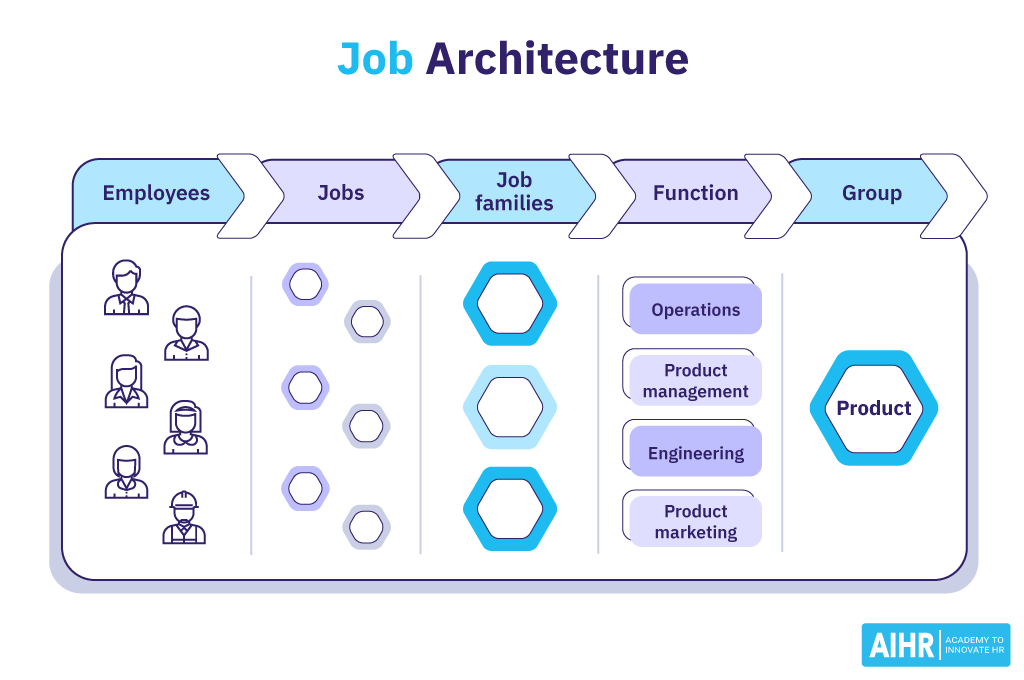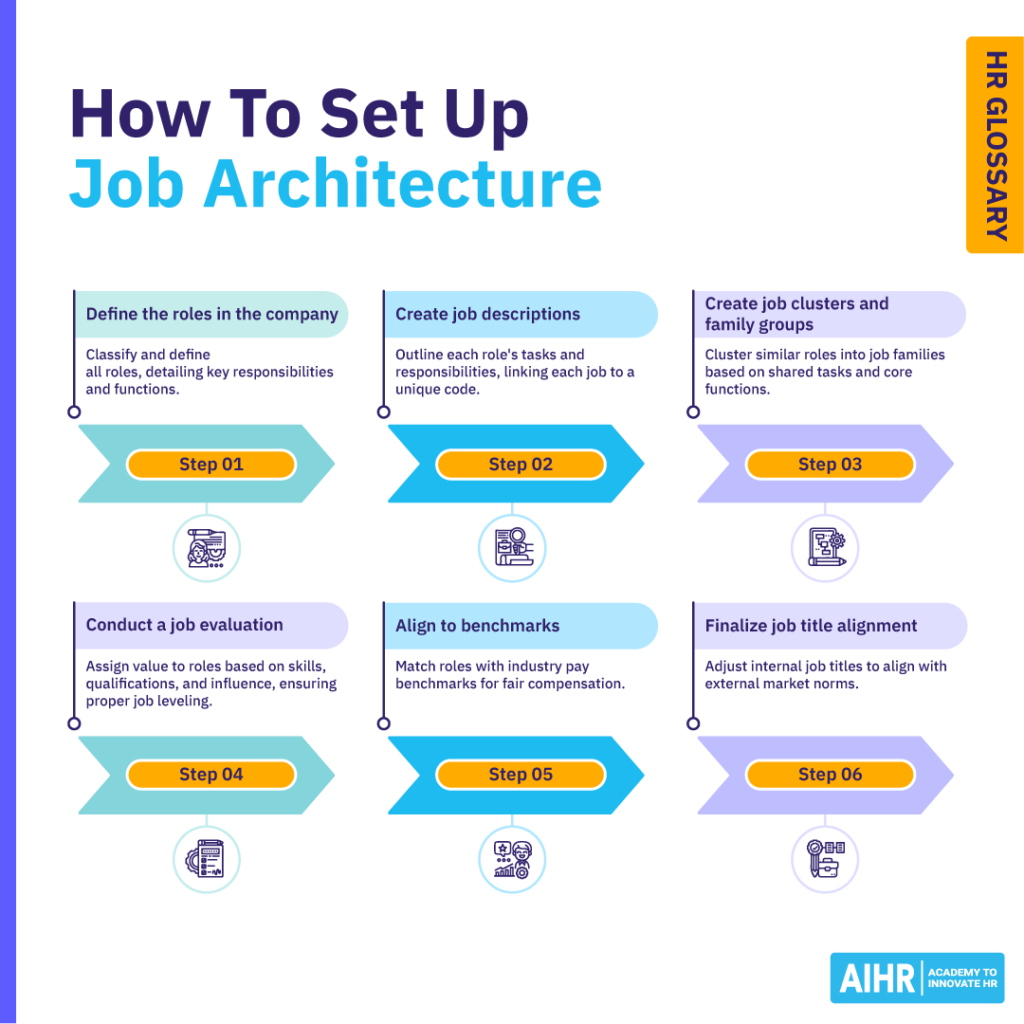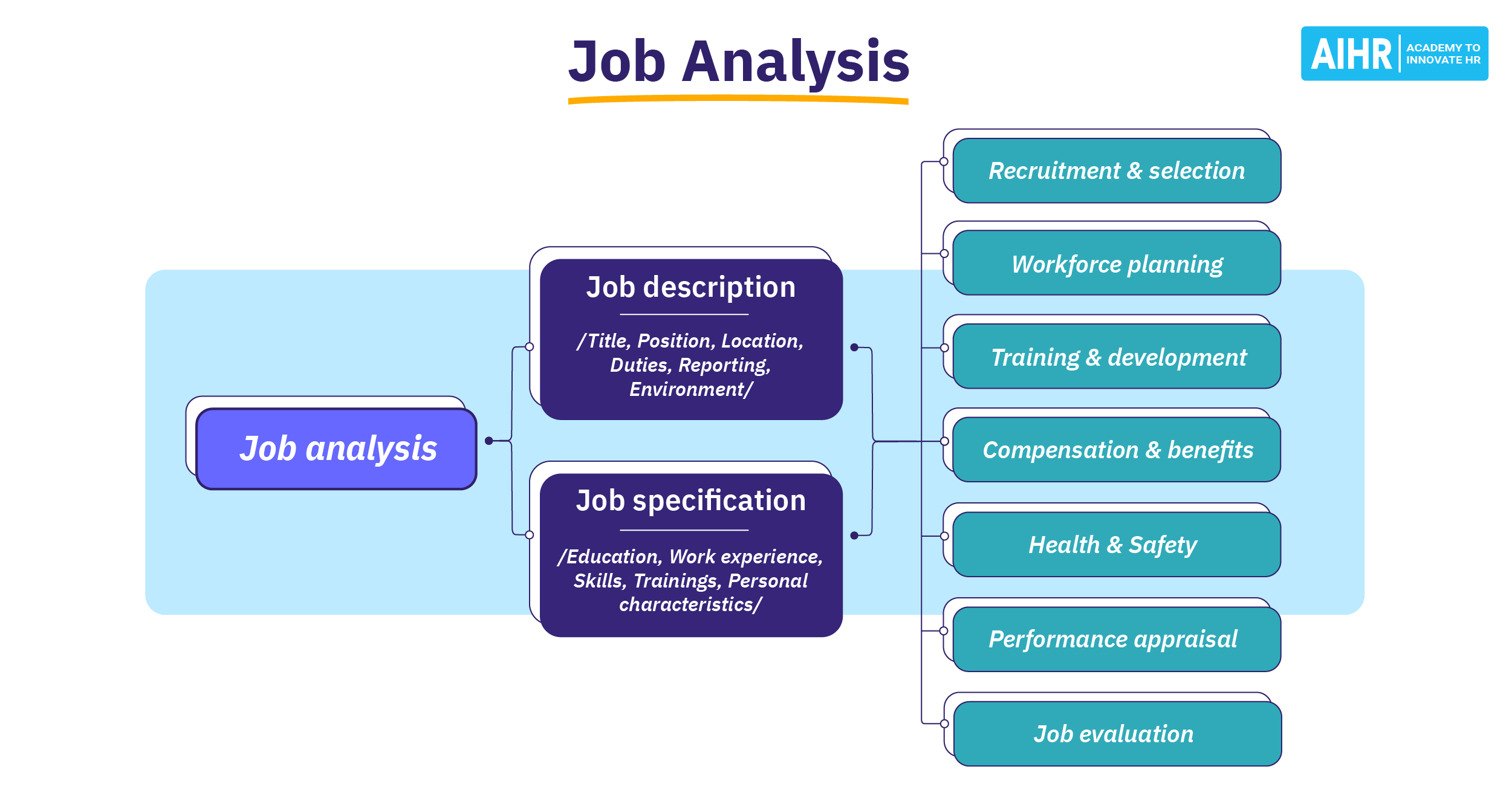Job Architecture
What is job architecture?
Job architecture is a framework that defines and organizes roles within a company, outlining job titles, responsibilities, and required skills. It ensures consistency in role evaluation and compensation, creating transparency and fairness across departments.
It also maps out career paths, helping employees understand how they can progress within the organization. This structure supports talent development, pay equity, and workforce planning, making it a key tool for managing an organization’s talent and aligning roles with business goals.

What are the components of job architecture?
The components of a job architecture typically include:
- Compensation structure: Pay scales or bands associated with each job level to ensure fair and consistent compensation across the company.
- Job families: Groupings of similar roles based on function or expertise (e.g., marketing, engineering).
- Job levels: Tiers within job families that reflect varying degrees of responsibility, expertise, or experience (e.g., entry-level, mid-level, senior).
- Job titles: Specific names assigned to positions within each job family and level, providing clarity on the role (e.g., Marketing Manager, Software Engineer II).
- Job descriptions: Detailed summaries of a role’s responsibilities, tasks, and required qualifications or skills.
- Competencies: The skills, knowledge, and abilities required to perform a job effectively, often tied to both current and future performance expectations.
- Career paths: Clear progression routes within or across job families that show how employees can move vertically or horizontally in the organization.
Job architecture examples
Here are a few examples of job architecture frameworks across different industries and organizations:
Example 1: Tech company job architecture
In a tech company, job architecture might include job families such as Engineering, Product Management, and IT Support. Each family is broken down into levels, like entry-level, junior, mid-level, senior, and lead. For example, within the Engineering family, you could have:
- Software Engineer I (entry-level)
- Software Engineer II (mid-level)
- Senior Software Engineer (senior)
- Lead Software Engineer (lead)
Each level would have defined responsibilities, required skills, and clear progression criteria, allowing employees to see how they can advance in their careers.
Example 2: Healthcare job architecture
In a hospital or healthcare system, job families might include Nursing, Administration, and Medical Specialists. Within the Nursing family, job levels could include:
- Registered Nurse I (entry-level with a basic skill set)
- Registered Nurse II (mid-level, able to handle more complex cases)
- Nurse Practitioner (advanced level with the ability to diagnose and prescribe)
- Nursing Manager (leadership role overseeing a team of nurses)
The structure clearly outlines the competencies and qualifications needed to move from one role to another, ensuring clear career pathways.
The benefits of job architecture
Job architecture offers several key benefits to organizations and employees alike. Here’s a breakdown of its advantages:
- Clarity in roles and responsibilities: Job architecture helps define each position’s tasks and expectations. This reduces confusion and overlap between functions, making it easier for employees and managers to understand their roles within the company.
- Fair and consistent compensation: It ensures fair and consistent compensation. By aligning job levels with compensation structures, organizations can prevent pay discrepancies and create equity across the workforce, providing clear salary ranges for similar roles.
- Clear career pathways: It offers transparent career paths that allow employees to see how they can advance within the company or move horizontally into new roles. This promotes internal mobility and enables employees to plan their careers, boosting engagement and motivation.
- Improved recruitment and talent acquisition: Job architecture allows recruiters to define roles and attract the right candidates accurately. Prospective employees gain a better understanding of the role and available growth opportunities, leading to higher satisfaction and retention.
- Enhanced talent development: Job architecture supports talent development by mapping out the skills, competencies, and qualifications needed for progression. Managers can create targeted development plans for employees, ensuring structured growth and measurable progress.
- Informed workforce planning: It aids in workforce planning by helping HR and leadership identify skills gaps and align the workforce with business objectives. This ensures the organization has the right talent in place to meet strategic goals.
- Streamlined performance management: Job architecture establishes clear expectations for each role, making performance evaluations more objective and consistent across departments. This leads to a fairer and more transparent assessment process.
Job architecture versus organization reporting structure
Job architecture and organization reporting structure are related but distinct concepts in managing talent and organizational design.
Focus
Defines roles, responsibilities, and career paths
Outlines the hierarchy and reporting relationships
Purpose
Provides a framework for consistent job titles, levels, and pay
Establishes who reports to whom and the flow of authority
Key components
Job families, levels, titles, job descriptions, competencies, and compensation
Organizational chart, reporting lines, management structure
Emphasis
The “what” and “how” of roles within the company
The “who” (who reports to whom and who has decision-making power) in the organization
Use in HR
Supports talent management, compensation, and career development
Defines accountability, communication, and decision-making processes
How to set up your job architecture
Setting up job architecture requires a structured approach to organizing roles within a company, ensuring consistency and clarity around job levels, titles, responsibilities, and pay ranges. Here’s how to get started:
- Define the roles in the company: The first step is to classify and define all roles in the company, which comprises a set of roles and responsibilities. The responsibilities can be split up and extended beyond the job function.
- Create job descriptions: A job description outlines an employee’s responsibilities and tasks. In a Human Resources Information System (HRIS), a job is usually linked to a unique job code.
- Create job clusters and family groups: A job family is a cluster of similar jobs sharing professional and core tasks. The more similar the characteristics of a job family, the easier it is to cluster them into sub-families.
- Conduct a job evaluation: This is where job leveling—systemically and accurately assigning value to individual roles—plays a big role. This value is determined by the knowledge, qualifications, and skills required to do the job. It also takes into account the role’s influence and outcome. Completing a job evaluation facilitates accurate job title alignment.
- Align with benchmarks: Once you’ve confirmed all job titles and levels within an organization, aligning the individual roles with their respective pay benchmarks becomes easier. This allows you to set the appropriate salary levels and establish correct and fair compensation structures.
- Finalize job title alignment: It’s important to revisit your organization’s job titles after taking into consideration external benchmarks. The title of an internal role might differ from its common name in external benchmarks. A title should be market-related and should follow internally established norms and conventions.

FAQ
Job architecture matters as it provides a clear structure for defining roles, responsibilities, and career paths within an organization. It helps standardize job titles, compensation, and progression, ensuring consistency across departments. This structure supports better talent management, aids in workforce planning, and promotes fairness in pay and career development opportunities.
Job architecture focuses on defining roles, responsibilities, and career paths, aligning job titles and compensation across the organization. Organizational structure, on the other hand, refers to how teams and departments are arranged, including reporting relationships and hierarchies. While job architecture standardizes roles and progression, organizational structure defines how work is coordinated and who reports to whom.









